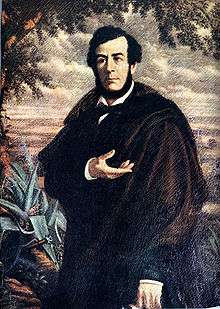Esteban Echeverría
José Esteban Antonio Echeverría (September 2, 1805 – January 19, 1851) was an Argentine poet, fiction writer, cultural promoter, and political activist who played a significant role in the development of Argentine literature, not only through his own writings but also through his organizational efforts. He was one of Latin America's most important Romantic authors.
José Esteban Antonio Echeverría | |
|---|---|
 Portrait of Esteban Echeverría. | |
| Born | September 2, 1805 Buenos Aires |
| Died | January 19, 1851 (aged 45) Montevideo |
| Language | Spanish language |
| Nationality | |
| Alma mater | Sorbonne |
| Literary movement | Romanticism |
| Notable works | El Matadero, La Cautiva |
Life
Echeverría spent five decisive years in Paris (1825 to 1830), where he absorbed the spirit of the Romantic Movement, then in its heyday in France. He became one of the movement's promoters once he returned to Argentina. Once he returned to Buenos Aires, he wrote "Los Consuelos" in 1834 and "Las rimas" in 1837. He was a member of the group of young Argentine intellectuals who in 1840 organized the Asociación de Mayo ("May Association", after the May Revolution that initiated Argentina's move towards independence). This institution aspired to develop a national literature responsive to the country's social and physical reality. Echeverría also devoted himself to the overthrow of the caudillo of Buenos Aires, Juan Manuel de Rosas. In 1840 he was forced to go into exile in nearby Uruguay, where he wrote La Insurrección del Sur and El Matadero.
He remained in Uruguay until his death in 1851. His remains are said to be buried at Buceo Cemetery.[1]
Work
Echeverría's renown as a writer rests largely on his powerful short story El matadero ("The Slaughter Yard", often mistranslated as "The Slaughterhouse"), written in sometime during 1838-1840 but not published until 1871), a landmark in the history of Latin American literature. It is mostly significant because it displays the perceived clash between "civilization and barbarism", that is, between the European and the "primitive and violent" American ways. Domingo Faustino Sarmiento, another great Argentine writer and thinker, saw this clash as the core of Latin American culture. Read in this light, "The Slaughterhouse" is a political allegory. Its more specific intention was to accuse Rosas of protecting the kind of thugs who murder the cultivated young protagonist at the Buenos Aires slaughterhouse. Rosas and his henchmen stand for barbarism, the slain young man for civilization.
Echeverría's La cautiva ("The Captive"), a long narrative poem about a white woman abducted by Mapuche Indians, is also among the better-known works of 19th-century Latin American literature.
Esteban Echeverría Partido
- Esteban Echeverría Partido is a district in Gran Buenos Aires, Argentina. It was founded on April 9, 1913 and named in honor of Echeverría.
Works
- Elvira o la novia del Plata (1832)
- Don Juan (1833)
- Carlos
- Mangora
- La Pola o el amor y el patriotismo
- Himno del dolor (1834)
- Los consuelos (1834)
- Al corazón (1835)
- Rimas (1837, en GB)
- La cautiva
- El matadero (between 1838 y 1840)
- Canciones
- Peregrinaje de Gualpo
- El Dogma Socialista
- Cartas a un amigo
- El ángel caído
- Ilusiones
- La guitarra
- Avellaneda
- Mefistófeles
- Apología del matambre (1837)
- La noche
- La diamela
References
- "Burial of Esteban Echeverría". Find A Grave. Retrieved 2013-03-03.
William H. Katra, The Argentine Generation of 1837: Echeverría, Alberdi, Sarmiento, Mitre (Madison, N.J.: Fairleigh Dickinson University Press, 1996)
External links
- Works by or about Esteban Echeverría at Internet Archive
- Works by Esteban Echeverría at LibriVox (public domain audiobooks)

- "El matadero"